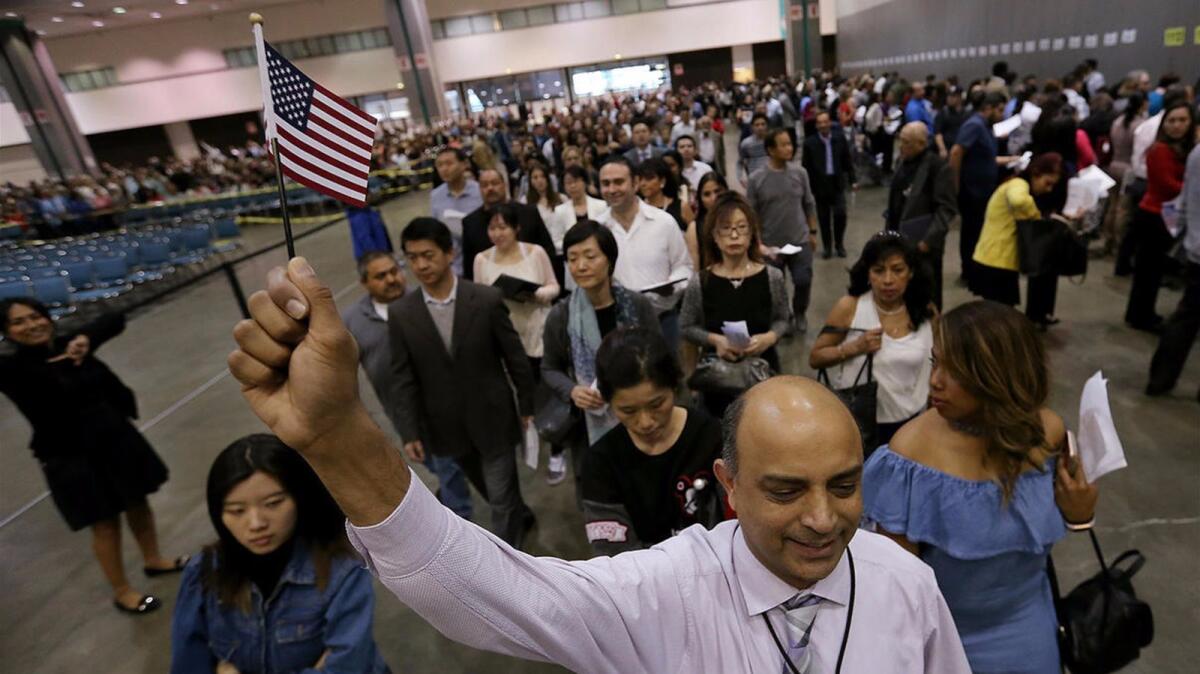Trump’s push for ‘merit-based’ immigration may not deliver the benefits he expects

President Trump wants to reform the immigration system to favor foreigners who have special skills that would contribute to the U.S. economy, breaking from a decades-long practice of giving preference to family members of U.S. citizens and permanent residents.
But switching to a “merit-based” system like Canada’s and Australia’s, which Trump endorsed in his speech to Congress recently, is fraught with political landmines and administrative hurdles.
And there are serious questions about whether it will deliver the kinds of large-scale economic benefits that the president and his supporters envision.
While in many ways a patchwork, the U.S. immigration system is already attracting many of the best and brightest from around the globe. Trump’s characterization of U.S. immigration as a flood of low-skilled migrants draining public finances is more a picture of the past. Amid shifting migration patterns and rising incomes globally, new arrivals to the U.S. are increasingly better educated and well off.
In 2000, about one-fourth of all immigrants in the U.S. age 25 and over had at least a bachelor’s degree. By 2015 that rose to 31.4% — nearly the same rate as people born in the U.S., according to the Census Bureau. The percentage of immigrants with graduate degrees now exceeds those of native-born Americans.
After waves of immigration from Europe and then Mexico and Central America, the new arrivals to the U.S. are increasingly from Asia, largely India and China, the two most populous and fastest-growing major economies in the world. In fiscal 2016, about half of all family-based green cards went to those from Asia, and four out of five who were admitted with employment certifications originated from there. Now many are waiting to bring in their parents and siblings.
The larger inflows from Asia’s growing affluent class partly explains the increase in immigrants’ education and skill levels — and that trend is likely to continue even without converting to a merit-based system, which Giovanni Peri, a specialist in international migration economics at UC Davis, sees more as a maneuver aimed at drastically cutting immigration.
“The truth is that the U.S. has had the highly skilled coming in, and in very large numbers, throughout its history and the last 15 years in particular,” Peri said.
It’s true that there’s a much larger share of low-skilled immigrants without a high school diploma as compared to the overall population. And research has shown their presence can have a harmful, short-term effect on U.S.-born low-skilled workers.
But in the long run, experts widely agree that greater immigration provides a net economic benefit to the U.S., lowering the cost of goods and services as well as enlarging the labor and consumer base.
Over the past decade, immigrants have accounted for nearly 60% of the increase in the U.S. workforce, offsetting the shrinking growth from an aging American population, low birthrates and declining labor participation from prime-age men. An expanding labor force is a key part of economic growth.
In a report last week, the Pew Research Center estimated that, assuming current levels and demographics of immigration, the number of people 25 to 64 years old in the U.S. would grow by 10 million between 2015 and 2035. Without them and their children, the working-age population would fall by almost 8 million in 20 years.
“There’s no economic rationale for lowering it,” said Pia Orrenius, senior economist at the Federal Reserve Bank of Dallas, referring to the immigration level.
Angus Deaton, the Princeton University professor and 2015 Nobel laureate in economics, said low-skilled immigration sometimes yields unexpected benefits.
“When I think about children of immigrants, parents were not particularly skilled but they had a really deep belief in education,” Deaton, himself an immigrant from Scotland, said in an interview. “And they’ve come to the U.S. and have done amazing things, not just for themselves but for everyone else.”
Trump has said nothing precise about his desired immigration numbers, although in a major speech as a candidate last summer he called for keeping “immigration levels, measured by population share, within historic norms” — language that groups have used when pointing to the 1960s and ‘70s, when the immigrant share of the nation’s population was about one out of every 20 people, rather than one in eight as it is today.
Health secretary: Obamacare replacement will leave no one ‘worse off financially’ »
Michael Short, Trump’s head of legislative affairs, wouldn’t comment about moving to a merit-based approach beyond stating that the president has expressed support for the idea. But Sen. Tom Cotton (R-Ark.), who has talked with Trump about immigration and seems to be in line with his thinking, joined Sen. David Perdue (R-Ga.) in introducing legislation that would not only reorient policy to favor the highly skilled, but also slash total immigration by 40% to 50%, largely by limiting family-sponsored visas and cutting refugee entrants in half.
The U.S. admits roughly 1 million legal immigrants a year. About two-thirds are immediate family of citizens, or family members sponsored by permanent residents already in the U.S. Another 144,000, according to 2015 figures, gain permanent entry, or green cards, through employment certifications.The remainder come in as refugees or through asylum and a lottery program to promote diversity.
It’s basically the reverse in Canada, where a majority are admitted as “economic migrants,” based on a point system that includes education, fluency in English and work experience. Even so, getting in hasn’t meant they were landing jobs in Canada. Many were taking a long time to find work, and others ended up toiling in occupations far below their skills.
So prevalent was the problem last decade that it became something of a national crisis, said Jeffrey Reitz, an immigration expert at the University of Toronto. The result has been frequent tinkering of the point system — it now gives heavy weight to immigrant applicants with job offers — and constant monitoring of labor markets and the skills in demand. Even then, policy analysts wonder whether the “merit” system shouldn’t be expanded to capture other subjective criteria, such as a person’s ability to work in teams and entrepreneurial leanings.
“It just illustrates, in general, merit may be in the eye of the beholder,” said Reitz.
And whose eyes would make such determinations? For a point-based system to work in the U.S., the Department of Homeland Security, which oversees immigration services, would need to have the authority to make adjustments as Canadian authorities do, said Stephen Yale-Loehr, an immigration attorney and law professor at Cornell University.
But, he noted, “Congress traditionally has not been willing to give a lot of power and flexibility to the immigration agency.”
Other analysts worry that giving employers too much influence in selecting applicants on a merit-based system runs the risk of abuse in cherry-picking labor.
The political challenges to overhauling immigration preferences and quotas are even more daunting. No one thinks immigration reform can happen without first resolving the conundrum involving the 11 million immigrants in the U.S. illegally, although that number has been flat in recent years.
Even if Congress can get past that, though, various groups are certain to fight vehemently against a lowering of quotas for family reunification. Demetrios Papademetriou, president emeritus of the Migration Policy Institute, a nonpartisan think tank in Washington, predicted the biggest uproar will come from Asian Americans.
“There will be pushback,” said Papademetriou. “The Asian American community has always argued that, ‘You guys, you Europeans and Latinos, have been able to milk that system for decades, and now you’re going to deny that to us.’”
Follow me at @dleelatimes
ALSO
Fearful parents sign papers for friends to care for kids in case they’re deported
The question is: Who are you rooting for? Two economists, two views on immigration
Trump sees himself as a dealmaker and immigration reform as the ultimate deal to deliver







